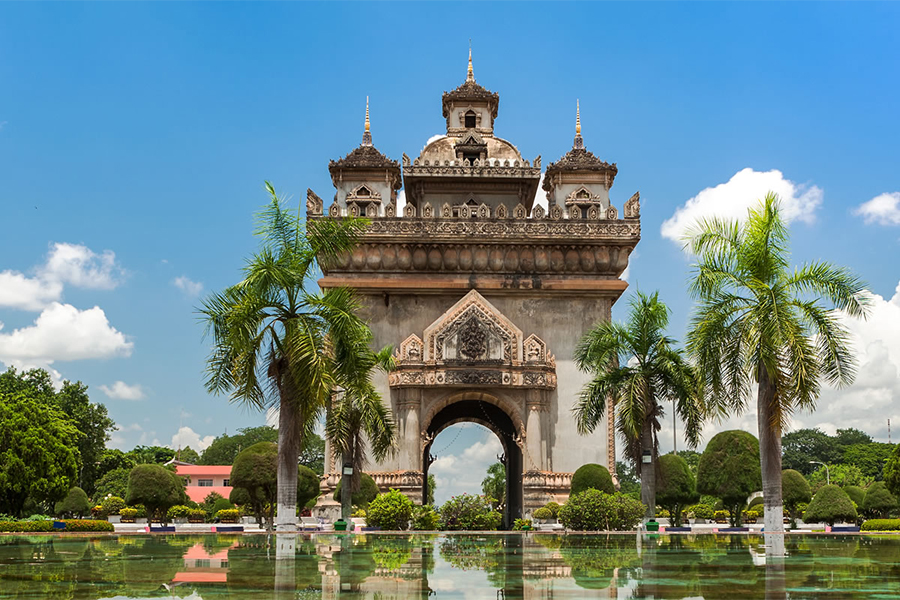Vientiane
Vientiane, the charming capital of Laos, is a city where history, spirituality, and a relaxed pace of life come together along the banks of the Mekong River. Unlike the bustling capitals of its Southeast Asian neighbors, Vientiane offers a slower, more intimate experience, where visitors can wander quiet streets lined with French colonial buildings, sip coffee in riverside cafés, and explore ancient temples that reflect the city’s Buddhist heritage.
One of Vientiane’s most iconic landmarks is the Pha That Luang, a golden stupa that stands as a symbol of Lao Buddhism and national pride. Believed to contain a relic of the Buddha, this grand monument is surrounded by smaller temples and intricately carved statues, creating a peaceful and spiritual atmosphere. Another highlight is the Wat Si Saket, the oldest surviving temple in Vientiane, known for its cloister walls lined with thousands of small Buddha statues. The nearby Wat Ho Phra Keo houses beautiful artifacts and once enshrined the revered Emerald Buddha, adding to the city’s rich spiritual heritage.
A stroll along Vientiane’s riverside at sunset reveals another side of the city’s charm. The Mekong riverside comes alive each evening with a vibrant night market, where locals and travelers browse stalls selling handicrafts, clothing, and traditional Lao street foods. The riverfront is also dotted with cozy bars and eateries, where visitors can unwind with a view of the Mekong as the sun sets over Thailand on the opposite shore.
The Patuxai Monument, sometimes called the “Arc de Triomphe of Vientiane,” adds a touch of architectural grandeur to the city. This distinctive structure, built to honor those who fought for independence from France, offers panoramic views of Vientiane from its upper level. Nearby, the COPE Visitor Centre provides a meaningful experience for those interested in learning about Laos’s history, particularly the legacy of unexploded ordnance (UXO) from the Vietnam War era, and the organization’s work to support survivors.
Vientiane’s café culture reflects the city’s French influence, with bakeries, coffee shops, and quaint restaurants offering French pastries alongside traditional Lao dishes like laap (a minced meat salad) and sticky rice. The relaxed pace of the city invites visitors to linger over a meal, explore the local art scene, or simply watch the world go by.
With its blend of historical landmarks, spiritual sites, and riverside charm, Vientiane is a welcoming city that captures the gentle, peaceful spirit of Laos. Whether exploring golden temples, shopping in the night market, or enjoying a sunset by the Mekong, Vientiane offers travelers a refreshing and authentic experience in the heart of Laos.
One of Vientiane’s most iconic landmarks is the Pha That Luang, a golden stupa that stands as a symbol of Lao Buddhism and national pride. Believed to contain a relic of the Buddha, this grand monument is surrounded by smaller temples and intricately carved statues, creating a peaceful and spiritual atmosphere. Another highlight is the Wat Si Saket, the oldest surviving temple in Vientiane, known for its cloister walls lined with thousands of small Buddha statues. The nearby Wat Ho Phra Keo houses beautiful artifacts and once enshrined the revered Emerald Buddha, adding to the city’s rich spiritual heritage.
A stroll along Vientiane’s riverside at sunset reveals another side of the city’s charm. The Mekong riverside comes alive each evening with a vibrant night market, where locals and travelers browse stalls selling handicrafts, clothing, and traditional Lao street foods. The riverfront is also dotted with cozy bars and eateries, where visitors can unwind with a view of the Mekong as the sun sets over Thailand on the opposite shore.
The Patuxai Monument, sometimes called the “Arc de Triomphe of Vientiane,” adds a touch of architectural grandeur to the city. This distinctive structure, built to honor those who fought for independence from France, offers panoramic views of Vientiane from its upper level. Nearby, the COPE Visitor Centre provides a meaningful experience for those interested in learning about Laos’s history, particularly the legacy of unexploded ordnance (UXO) from the Vietnam War era, and the organization’s work to support survivors.
Vientiane’s café culture reflects the city’s French influence, with bakeries, coffee shops, and quaint restaurants offering French pastries alongside traditional Lao dishes like laap (a minced meat salad) and sticky rice. The relaxed pace of the city invites visitors to linger over a meal, explore the local art scene, or simply watch the world go by.
With its blend of historical landmarks, spiritual sites, and riverside charm, Vientiane is a welcoming city that captures the gentle, peaceful spirit of Laos. Whether exploring golden temples, shopping in the night market, or enjoying a sunset by the Mekong, Vientiane offers travelers a refreshing and authentic experience in the heart of Laos.

